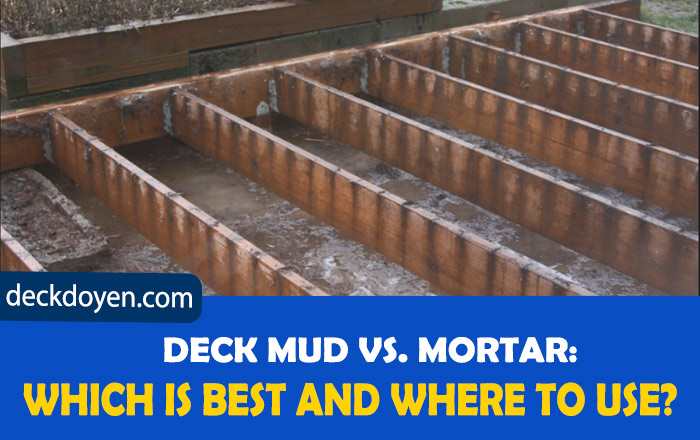The bedding materials that you use for the floor beds, such as Deck Mud and Mortar, need to be strong. Although they have similar compositions, the difference between their consistency, application, and benefits might be slightly different and can lead to functionality distinctions.
With that said, it’s best you figure out which material goes well for your construction project on time. So, which one to go for, Deck V/s Mortar? and what are the distinctions between them?
The mixture of Deck mud only includes cement and sand, while Mortar has lime Water too. Deck mud has a relatively medium consistency that is neither flowy nor bitter. Its most important function is to absorb shock. On the other hand, Mortar has flowy viscosity for hassle-free handling. Constructors use it on sites to defy gravity and stick cable lath.
Builders use both founding materials for floor bedding, but the outcomes are unique. Deck mud is suitable for floor tiling. On the other hand, Mortar is better for walls brick joining. That’s why I am here with a detailed comparison between these two building materials and help you get a clearer idea about each cementing material and its pros and cons!
Why Is Deck Mud Different From Mortar?
Lime is the element that differentiates deck mud from Mortar. Here are a few essential factors responsible for this variability between these cementing materials.
Autogenous Crack Filling Vs. Shock Absorbance:
Your walls and floors need to be tough and durable so that your home stays beautiful and robust for millennia. The house walls may start cracking after a mild earthquake or due to some pressure. At this moment, the Lime presence in the mortar mix enables autogenous crack filling in walls. How does autogenous crack filling take place? Well, the answer is simple. The lime powder is your mortar mix combined with the carbonate in the air and forms calcium carbonate that fills the gaps and cracks of your wall.
Also Read: Can You Install Trex Decking In The Winter? A Definitive Guide!
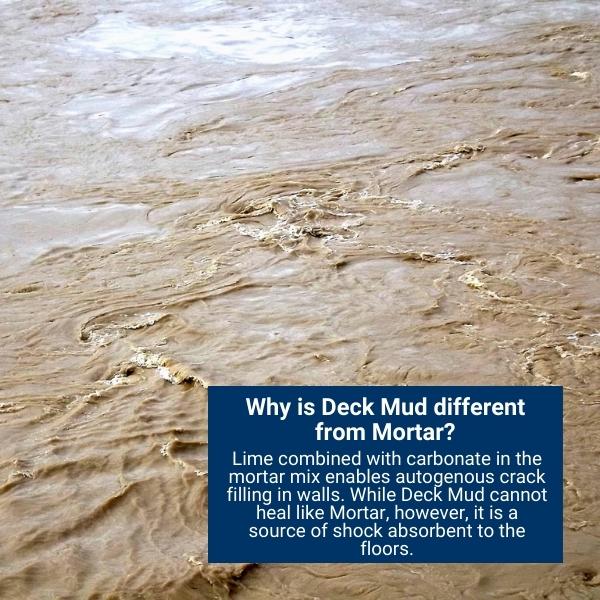
Deck mud cannot heal like Mortar and will not seal the cracks. However, the cracking in deck mud works as a shock absorbent on floors. It prevents your expensive and decorative flooring, tiles, and marbles from breaking due to weights and pressure. So, whenever you put pressure on your tile, cracks form in the soft bed of deck mud. Hence it fails to protect the top stone.
Easy-To-Handle:
Are you planning for a DIY project and renovating your home? Well, the handling and curing of cementing material are essential to learning for better application. Deck mud mixture formation is the challenging part of the task. A little less or more Water will not properly fix your tile. The correct viscosity is the key to handling it perfectly. The water content will also slow down curing and weaken your foundation.
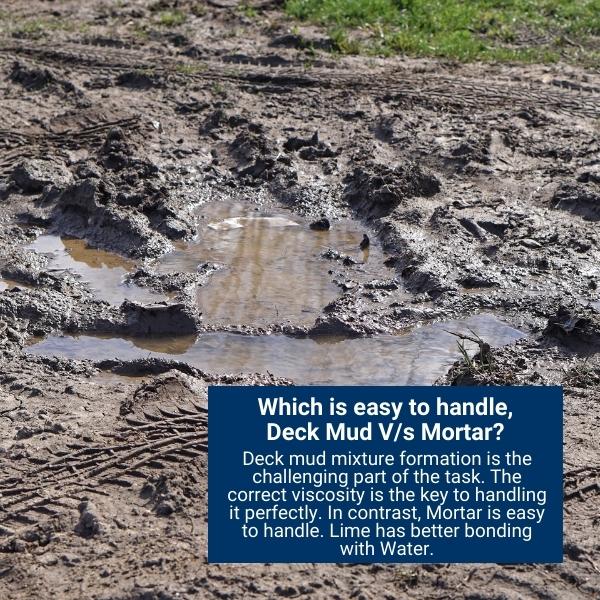
On the other hand, Mortar is easy to handle. Lime has better bonding with Water. The consistency of Mortar is softer than Water. Therefore, it is handy and manageable. The Lime stops the mixture from hardening quickly so that the mixture remains soft for hours. These characteristics allow easy handling and long-term use at construction sites.
Also Read: How Do I Know If My Deck Is Dry Enough To Stain?
Water Leakage – Deck Mud Vs. Mortar
Walls are more prone to absorb Water from water leakages, rains, and the atmosphere. Therefore, the cementing material should not be porous to absorb water and form cracks. Where deck mud has pores and provides space for Water to flow, Mortar is not. It doesn’t allow water to flow in and out.
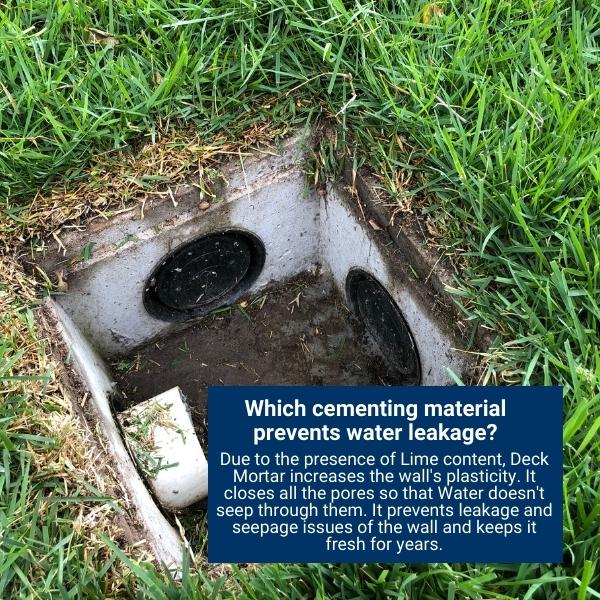
Besides, lime content increases the plasticity of the wall by closing all pores so that Water doesn’t seep through it. Thus, it prevents leakage and seepage issues of the wall and keeps it fresh for years. Deck mud is durable too, but it’s not suitable for areas near Water. So, always use Mortar for your walls and avoid deck mud as it may not let your wall stand for long.
Also Read: Best Wood For Decking: Which One To Choose And Why?
Drawback: However, Mortar starts crumbling if you expose the cementing to moisture before it gets air dry. Lime is soluble in Water. That’s why it will start breaking apart if you reveal it to Water before solidifying. So, never use it in a humid environment or add a lot of Water.
Cost:
Cost is also a factor that impacts the use of construction materials. It depends on how much he can spend on his house construction. That’s why a pocket-friendly pocket-friendly cementing material is also the best pick. Both deck mud and Mortar are pocket-friendly materials. Though, deck mud and Mortar have comparative pricing. The lime content of Mortar doesn’t make it out of the reach of a middle-class man. So, you can use both materials according to their respective usage.
Strong Vs. Elastic:
Deck mud makes the strong base of floors and works as a gluing material for tile. Though Water doesn’t combine it well, it withstands heavy weights effortlessly, keeping the tiles safe. In contrast, the lime part of the mortar mix makes it flexible. Mortar is also perfect for wall bricking because the lime content reacts with carbon dioxide in the air to automatically fill those cracks.
Durability:
Both cementing materials are durable in their place. Deck mud enhances the durability of floors, tiles, and shower beds. However, Mortar increases the stability of your walls. So, never interchange them. Deck mud and Mortar are vital for internal and external construction.
Also Read: When To Stain A New Deck Pressure Treated?
What Are The Different Compositions Of Deck Mud And Mortar?
Deck mud and Mortar both constitute cement, but Mortar has an additional ingredient. It completely changes the consistency and usage of Mortar. So, it’s all about the composition. Let’s help you out with it!
Composition Of Deck Mud:
Deck mud is the mixture of sand and cement in variable ratios. The suitable ratio most people use is one part of cement with four of sand. You can also use one part of cement with seven, six, or five of sand. Additionally, Water is essential to combine the two dry mixes. Even after adding Water, it remains in a slime-like thickness. It must not be flowy, or it will not bind well.
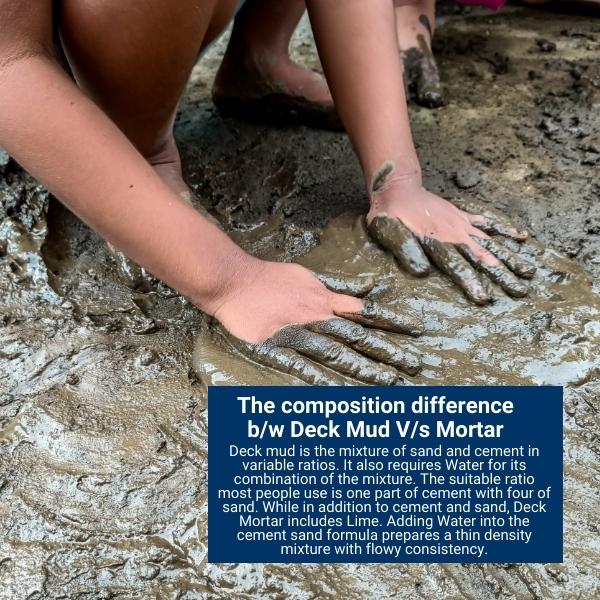
Composition Of Mortar:
In addition to cement and sand, Deck Mortar includes Lime. This mortar mix was first used by Egyptians for wall plasters in the ratio of 1:1:6 for Lime, cementing powder, and sand. The sand and other material mixes should have three parts to one ratio. Water is added to the cement-sand mixture and prepares a thin density mixture. It should have flowy consistency for proper handling.
Also Read: Best Treatment For Pressure-Treated Wood
What Are The Uses Of Mortar And Deck Mud?
Deck mud isn’t overly tight or fragile. It is not tough mud, which is decent to use for a flooring base. Superior shock and stress absorption minimize internal shatters instead of transferring structural loads as loads may damage tile work. On the other hand, Mortar has to work against gravity. It keeps your structures crack-proof and bounded for a longer duration. That’s why both have variable uses.
Uses Of Deck Mud:
You must lay all varieties of pavers, tile, stone, and marble over a deep bed of deck mud. It applies to surfaces such as floors, countertops, patios, driveways, shower pans, and anywhere else where a deep bed leveling deck mud is required. High traffic areas where additional flexural strength is essential, it is preferable that you use deck Mud. The setting of bed mortar for exposed stone landscapes and similar applications applies to any product.
Uses Of Mortar:
Most contractors apply Mortar in brick or blockwork to bond them together. It is helpful to provide a flat, level foundation among many brick or stone masonry layers so that pressure is distributed equally throughout the bed. People use it to fill the gaps between stones and bricks to tighten walls. Moreover, It also serves as a matrix in concrete. In plastering projects, it is necessary to conceal seams and enhance attractiveness. It is also usable for decorative and molding purposes.
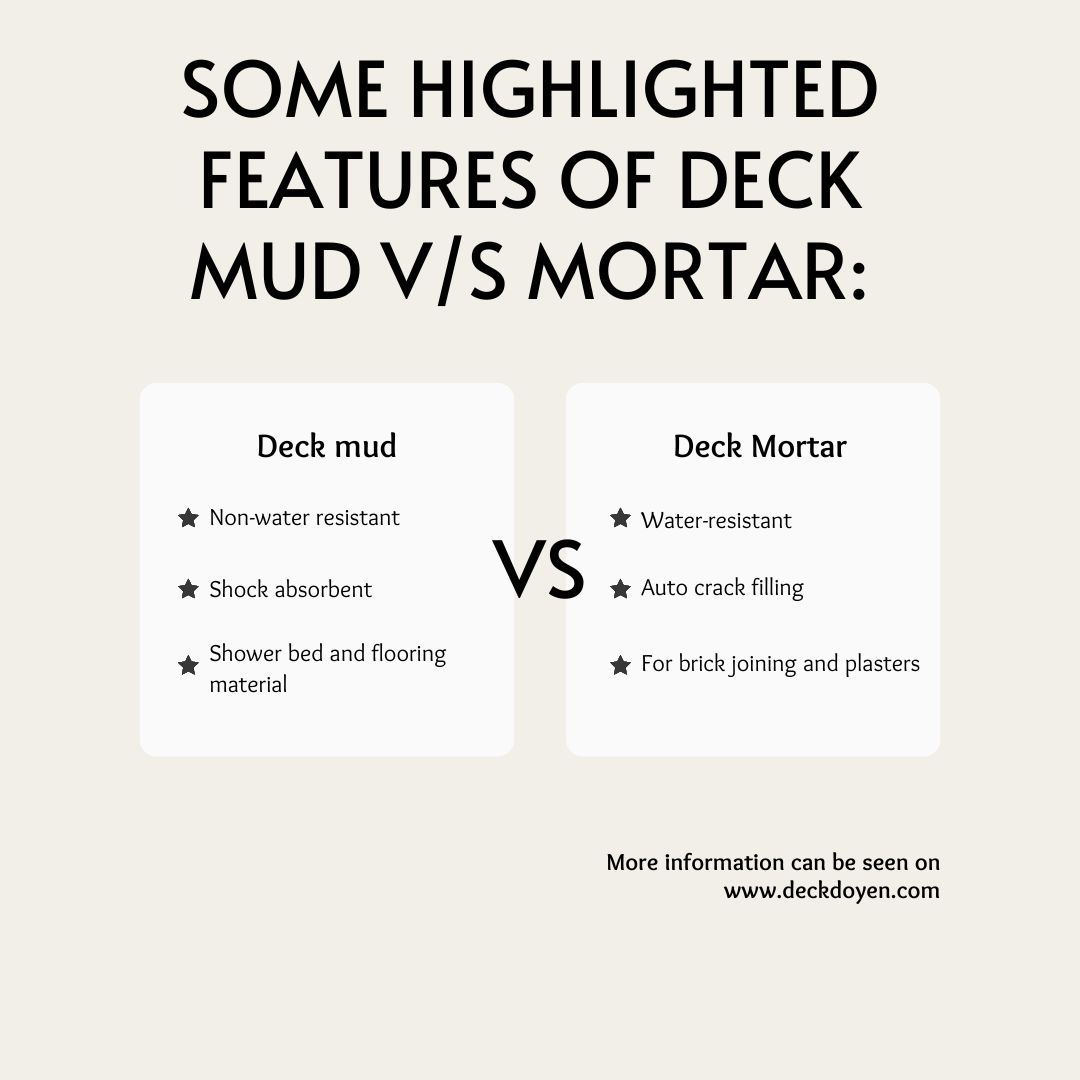
What Are The Benefits Of Deck Mud And Mortar?
Considering the comparative benefits of both materials after my extensive research, I came to the conclusion that both have importance on their grounds. So you can not appraise the one as a better option or a replacement for the other one.
The benefits of Mortar during the different phases of construction enable it to be an essential construction-related product. The lime-based Mortar is more flexible and less brittle. Since it is porous, moisture inside or outside will escape rapidly, making it last longer. They absorb carbonic acid from the environment and toughen into a solid block.
Also Read: Deck Blocks Vs. Post Holes: Which One To Use And Where?
On the other hand, the deck mud has completely different usability. It has a thick sand-like consistency, that’s why it is suitable for bedding floors and forming shower beds. The multiple layering of deck mud enables the formation of sloppy grounds and tiled footings. The layers of a thick bed of deck mud are suitable for all kinds of pavements, tiling, masonry, and travertine due to its thick consistency. It has moisture control and shock absorbance. Thus, it is also beneficial for efflorescence management and water repellency.
Conclusion:
An expert and experienced builder and contractor know what cementing material to use. He also understands where to use them. Deck and Mortar are valuable cementing materials, but inaccurate use can make them invaluable for you. That’s why you must wonder about what you want to build and the desirable results.
Deck mud is only a mixture of sand and cement with highly durable, shock absorbent, and water resistant abilities. These abilities are perfect for any tiling, shower, and floor bedding. So if you want to build lasting non-breakable flooring, use deck mud. It is the best choice!
However, if you want non-cracking, sturdy walls that don’t seep the leaking Water and stand tall, you should use Mortar. It is a mixture of lime sand and cement, so a better option to stop the seeping Water and self-filling of cracks.
In short, both are usable but require correct usage. Thus, if you want better results, never interchange them. Though these are cost-effective, interchanging them may cost you a repair shortly. So better to use the right one and save yourself from extra expenses and repairs!
Frequently Asked Questions:
What Should Be The Layer Thickness Of Deck Mud For Flooring?
The layer thickness of Deck Mud depends on how strong you want it. However, fill deck mud for at least half an inch for floors and shower beddings. It will be best to absorb shock. Any thickness less than half an inch may break your tiles.
Why Does The Mortar Start Cracking Early?
A new mortar bed fully carbonates and solidifies in years. One millimeter of carbonation happens in a month. Therefore, never add too much Lime. The more the calcium oxide, the slower the carbonation. Moreover, if it dries before enough carbonation, the cracks may start appearing. So, ensure you mist it with Water and protect it from the sun and tampering.
How Much Time Does Deck Mud Need To Dry?
Temperature and humidity affect the drying and curing of deck mud surfaces. It takes at least 24 hours to dry. However, the temperature should be optimal (21°C), and humidity should be up to 55%. Additionally, it completely cures in a month.
How Long Does Mortar Take To Dry?
Lime keeps Mortar flowy in the early hours for effortless handling. However, as time passes, the remaining Water evaporates, and it starts hardening at a quick pace. It doesn’t need curing but carbonation. It usually carbonates 1 mm in a month. So, it may take time to carbonate.
What Should Be The Ratio Of Lime In Mortar Mix?
The ratio of Lime in mortar mix should be equal to that of cement. Furthermore, the fraction of sand in this mixture should be three times the quantity after mixing Lime and cement. So the simple ratio between lime cement and sand is 1:1:3. It is preferable to use multiples.

